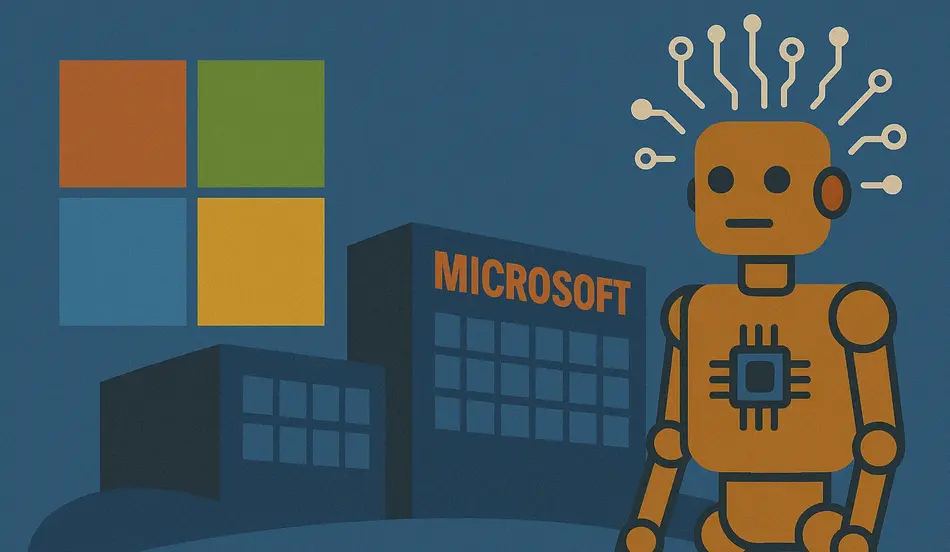Microsoft 50th anniversary marks a historic milestone for one of the world’s most transformative technology companies. Founded in 1975 by Bill Gates and Paul Allen, Microsoft has revolutionized how we live and work—through software, operating systems, cloud computing, and now artificial intelligence. From its early days with MS-DOS and Windows to its current leadership in AI under CEO Satya Nadella, the company’s journey reflects a powerful evolution in global tech leadership.
This comprehensive review explores the Microsoft 50th anniversary through three distinct leadership eras Gates, Ballmer, and Nadella highlighting the company’s major wins, challenges, and its strategic positioning for an AI-powered future.
Table of Contents
The Founding Era: How Gates and Allen Created the Software Industry
The Magic of the Windows Startup Sound
The iconic Windows startup sound still evokes nostalgia for millions worldwide. “It reminds me of a magic time. This feels like, you know, without it, there is no day that you could start,” says one longtime user. This simple audio cue represents Microsoft’s profound impact on computing culture and how the Microsoft tech revolution transformed personal computing from “a nerdy curiosity into a global necessity.”
Bill Gates: The Visionary Reader
Bill Gates, Microsoft’s co-founder and first CEO, was characterized by his “extraordinary curiosity” and reading habits. His leadership style focused on voracious information consumption and strategic thinking. Under Gates, Microsoft developed its core products like MS-DOS, Windows, and Office, establishing the company as the dominant force in personal computing software. This period laid the foundation for the Microsoft tech revolution that would reshape how we interact with technology.
Gates’ forward-thinking approach helped Microsoft secure the pivotal deal with IBM that would eventually make Windows the world’s most used operating system. His competitive drive and technical vision established Microsoft as an “indispensable and inescapable force” in technology.
The Ballmer Years: Navigating Challenging Waters
Steve Ballmer: The Numbers Man
Steve Ballmer, Microsoft’s second CEO, brought a different leadership style to the company. As one insider notes, “Steve studies numbers, finds patterns and pictures in them, and loves talking with people.” His tenure from 2000 to 2014 saw Microsoft navigate through significant challenges, including the rise of internet companies, mobile computing, and cloud services.

Missing Key Technology Waves
During this period, Microsoft missed several critical technology shifts. As one former executive admits, “I’d sit up all night thinking, oh, we’re gonna miss this, we’re gonna miss that.” The company struggled to compete effectively in mobile with Windows Phone and watched as Apple and Google dominated the smartphone revolution. Despite these setbacks, Microsoft maintained its core business strength through Office and Windows, demonstrating the resilience of the Microsoft tech revolution.
Ballmer’s Microsoft did make some significant strategic moves, including the development of Xbox, which successfully established the company in the gaming industry, and the acquisition of Skype, which later became an important communication tool.
🎉 Celebrate Innovation: Explore Tech Careers on WhatJobs
Inspired by the Microsoft 50th anniversary and its legacy of tech leadership?
Discover exciting opportunities in AI, Cloud Computing, Software Development, and Data Science—the fields driving the next 50 years of innovation.
WhatJobs connects you with future-focused employers shaping the digital economy through bold innovation and technology leadership.
👉 Browse top tech jobs now — and be part of the future of innovation.The Nadella Transformation: Cloud Computing and AI
Satya Nadella: The Renaissance Man
When Satya Nadella took over as CEO in 2014, he was described as “the Renaissance man CEO.” His leadership has been marked by a cultural shift within Microsoft, embracing open-source technologies and refocusing the company on cloud computing and artificial intelligence. Under Nadella, Microsoft has experienced a remarkable resurgence, becoming one of the world’s most valuable companies once again.
Azure and Cloud-First Strategy
Nadella’s strategic pivot to “cloud-first, mobile-first” has paid enormous dividends. Microsoft Azure has grown to become a leading cloud platform, competing directly with Amazon Web Services. This shift represents perhaps the most successful adaptation in the company’s history, proving that the Microsoft tech revolution continues to evolve with changing technological landscapes.
Microsoft’s cloud business has become a major revenue driver, with Azure growing consistently at double-digit rates. This transformation has been complemented by the company’s successful transition of Office to a subscription-based model with Microsoft 365.
Constant Reinvention: The Secret to Microsoft’s Longevity
Hedging Bets on an Uncertain Future
Throughout its 50-year history, Microsoft has survived by “catching and capitalizing on technology waves, constantly hedging their bets over an uncertain future.” As one executive explains, “We’re always thinking about, okay, what happens tomorrow? What’s gonna happen tomorrow? Will the company keep going?”
This forward-looking mindset has allowed Microsoft to navigate significant technological shifts. According to industry analysts, the company’s ability to adapt to changing market conditions while maintaining its core strengths has been crucial to its longevity. The Microsoft tech revolution continues because of this adaptability.
The AI Frontier
Today, Microsoft is heavily invested in artificial intelligence, with significant investments in OpenAI and the integration of AI capabilities across its product lineup. This strategic focus positions the company at the forefront of the next major technological wave, potentially ensuring its relevance for decades to come.
Microsoft’s partnership with OpenAI and the integration of ChatGPT technology into Bing and other products demonstrates the company’s commitment to leading in the AI era. This represents the latest chapter in the ongoing Microsoft tech revolution.
Hiring in Tech?
Looking for top talent to drive your company’s tech revolution? Post jobs for free with WhatJobs and connect with skilled professionals in software development, cloud computing, and AI.
Learning from Microsoft’s Journey: Key Takeaways for Businesses
- Embrace change: Microsoft’s willingness to pivot and adapt to new technological paradigms has been crucial to its survival.
- Leadership matters: Each CEO brought different strengths that were needed during their respective eras.
- Invest in the future: Microsoft consistently allocates resources to research and development, allowing it to explore emerging technologies.
- Balance innovation with stability: While pursuing new opportunities, Microsoft maintained its core business strengths.
- Learn from failures: The company’s ability to learn from missteps like Windows Phone and Zune has helped it avoid similar mistakes.
As Microsoft celebrates its 50th anniversary, it stands as a testament to corporate longevity in the fast-changing technology sector. From its early days revolutionizing personal computing to its current position at the cutting edge of AI, the Microsoft tech revolution continues to shape how we work, communicate, and interact with technology.
The company’s journey has been, as one former executive puts it, “kind of a miracle.” With its current momentum in cloud computing and AI, Microsoft appears well-positioned to remain an “indispensable and inescapable force” in technology for years to come. The Microsoft tech revolution that began with a simple vision to put “a computer on every desk and in every home” has evolved into something far more profound—a company that continues to shape the technological foundation of our world.
FAQ About Microsoft’s Tech Revolution
How has the Microsoft tech revolution impacted personal computing?
The Microsoft tech revolution transformed personal computing from a niche hobby to a global necessity. Through Windows and Office, Microsoft created standardized platforms that made computers accessible to billions of people worldwide. This democratization of computing power fundamentally changed how people work, communicate, and access information, establishing digital literacy as an essential skill in modern society.
What were the biggest challenges Microsoft faced during its 50-year tech revolution?
During its 50-year tech revolution, Microsoft faced numerous existential challenges, including the antitrust case in the late 1990s, missing the mobile computing wave in the 2000s, and adapting to cloud computing. The company also struggled with internal cultural issues that sometimes hindered innovation. Each challenge required significant adaptation, with the most successful response being Nadella’s cloud-first strategy that revitalized the company in the 2010s.
How is Microsoft positioning itself for the future of the tech revolution?
Microsoft is positioning itself at the forefront of the next phase of the tech revolution by heavily investing in artificial intelligence, cloud computing, and mixed reality. Its significant stake in OpenAI and integration of AI across its product ecosystem demonstrates its commitment to leading in these emerging technologies. Microsoft is also focusing on sustainability and accessibility initiatives, recognizing that the future tech revolution must address global challenges while remaining inclusive.
What lessons can other companies learn from Microsoft’s tech revolution journey?
Companies can learn several valuable lessons from Microsoft’s tech revolution journey: the importance of strategic adaptability, the need to balance innovation with maintaining core business strengths, the critical role of leadership in navigating transitions, and the value of long-term thinking. Microsoft’s ability to recover from missed opportunities and pivot to new technologies demonstrates that even large organizations can reinvent themselves when faced with disruptive change in the tech revolution landscape.
How has Microsoft’s approach to the tech revolution changed under different CEOs?
Each Microsoft CEO brought a distinct approach to leading the tech revolution: Gates focused on establishing software dominance through aggressive competition and technical vision; Ballmer emphasized business execution and diversification into hardware while struggling with emerging trends; and Nadella has embraced openness, cloud computing, and AI while fostering a growth mindset culture. These different leadership styles reflected the changing technological and competitive landscape during each era of Microsoft’s tech revolution.




